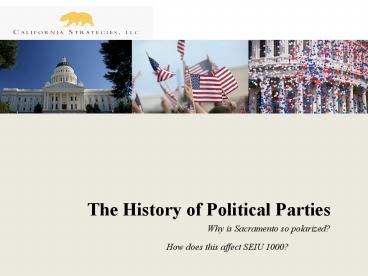The History of Political Parties - PowerPoint PPT Presentation
1 / 18
Title:
The History of Political Parties
Description:
The History of Political Parties Why is Sacramento so polarized? How does this affect SEIU 1000? * HISTORICAL OVERVIEW OF AMERICAN POLITICS Presidential ... – PowerPoint PPT presentation
Number of Views:129
Avg rating:3.0/5.0
Title: The History of Political Parties
1
The History of Political Parties
Why is Sacramento so polarized?
How does this affect SEIU 1000?
2
HISTORICAL OVERVIEW OF AMERICAN POLITICS
Presidential Elections and the Realignment of
American Politics
Americans adjust their political mood through
presidential elections
3
1932-1964AGE OF CLASS POLITICSBoth parties
ideologically balanced
- HAVES
- Eastern WASP
- Establishment (liberal)
- Midwestern Main Street
- Establishment (conservative)
- HAVE-NOTS
- Northern white liberals
- Southerners (conservative)
- Farmers (conservative)
- Minorities (liberal)
4
1964-1988THE CONSERVATIVE REALIGNMENT
Liberal vs. Conservative Class politics ebbs
- Southern, white, agrarian, conservative Democrats
abandon their party for Republicans. The
monolithic Democrat South fractures. - Northern, white, moderate/liberals leave the
Republican Party. The Rockefeller Wing of the
GOP atrophies. - Both shifts occur at the presidential level but
take another generation to take effect at the
local level.
5
ERA OF CONSERVATIVE IDEOLOGICAL POLITICS
6
1980 THE TRIUMPH OF IDEOLOGICAL REALIGNMENT
Ronald Reagan unites the three wings of the
Republican Party
7
1992AFTER THE FALL OF COMMUNISM
The Three wings of the Republican Party were no
longer unified by Anti-Communism. The economic
and religious wings were left to wonder what they
had in common. The GOP was pulled to the right by
Pat Buchanan and Christian Conservatives. Clinton
runs and wins election as a New Democrat.
8
1994-2000THE BATTLE FOR THE CENTER
Socially tolerant, small government voters define
elections
- 1994 Republicans won by a landslide when the
issues were government run healthcare, midnight
basketball and Clintons budget (higher taxes).
Voters dont want bigger government, especially
when their pocketbooks take a hit. - 1996 Clinton shifts to middle by making the
issues the balanced budget, Medicare, and welfare
reform. Republicans shut down government and move
to the right. - 1998 GOP failed to gain seats in an off-year
election when the Democrats controlled the
Presidency due to the moralizing over Monica
Lewinsky. - 2000 Both sides target middle and attempt to
push opposition to the ideological extremes.
Closest election in 100 years.
9
2004-2008THE BATTLE FOR THE CENTER CONTINUES
- 2004 Bush wins 255 Congressional Districts and
62 million votes were the most individual votes
ever cast for anyone in history and the first
president to receive a majority since George H.
W. Bush in 1988. - 2006 GOP loses control or the House of
Representatives and the US Senate. Congressional
corruption and government spending were the
biggest reasons cited by voters who voted GOP in
2006 but switched to Democrat in 2008. - 2008 Republicans lose 3 congressional seats in
safe Republican seats that President Bush
carried by double digits. All three Republican
candidates had more than enough resources to
mount successful campaigns.
2008 Barack Obama elected president by capturing
center. Democrats expand congressional and
legislative majorities.
10
Californias Growing Decline-To-State Voters
Voter Registration Trends 1992-Present
2008
11
When you advocate in Sacramento it might be
necessary to have two different messages
- One message for Republicans
- A different one for Democrats
12
- Groups that Republicans act favorably to
- Business groups
- Taxpayer organizations
- Church leadership
- Public safety leaders
- Parental rights groups
- Families with children
- Families Values Groups
- Tribal Interests
- Litigation Reform Groups
- Political Contributors
- Groups Democrats act favorably to
- Labor Unions
- Trial Lawyers
- Anti-Poverty Groups
- Environmental Organizations
- Womans Rights Groups
- Gay Rights Organizations
- Tribal Interests
- Political Contributors
13
Effective Lobbying Engages the Senses
- Vision 75
- Hearing 13
- Touch lt 5
- Taste lt 5
- Smell lt 5
The best advocacy is in-person with an easy to
understand visual presentation by a friend. The
most effective lobbying entails requires a
follow-up.
14
What are the challenges and opportunities the
State/legislature is facing in the next few
years?
Challenges (Have we reached a Tipping Point)
- Protecting California's Future
- (Are we special enough not to become another
Detroit) - Fundamental Restructuring/Reform
- (If they continue to fail to act)
- Reforming the Service Delivery System
- Reforming the Tax Code
- Dealing with an Increasingly Diverse Population
- Opportunities
- Unlimited
15
Is Local 1000 relevant in this setting?
Only if it chooses to be.
16
What will Local 1000 need to do differently as a
result of these challenges and opportunities?
1. Recognize that the old rules no longer
apply. 2. Become a part of the change rather
than trying to deny historical trends. 3.
Understand that it will take creative thinking
and much angst as the system evolves and
the organization reacts to it. 4. Set
member expectations where they need to be.
17
What will Local 1000 need to do differently to
maximize its effectiveness in order to
respond to the challenges?
- Continue to establish a reputation for
thinking - outside the box
- Continue to outreach to both sides of the isle
- Ensure that no one person/political
party/organization - Takes you for granted
- Writes you off
- Remember the words of Dr. Emmitt Brown
18
Jim Brulte, Partner California Strategies 10681
Foothill Blvd. Suite 340 Rancho Cucamonga, CA
91730 (909) 945-2250 (O) (909) 945-2966
(F) (916) 919-3097 (C) (909) 922-5039 (H)
SenatorJim31_at_aol.com





![get⚡[PDF]❤ The History of Political Parties (A Look at U.S. Elections) PowerPoint PPT Presentation](https://s3.amazonaws.com/images.powershow.com/10049545.th0.jpg?_=202406070212)

























